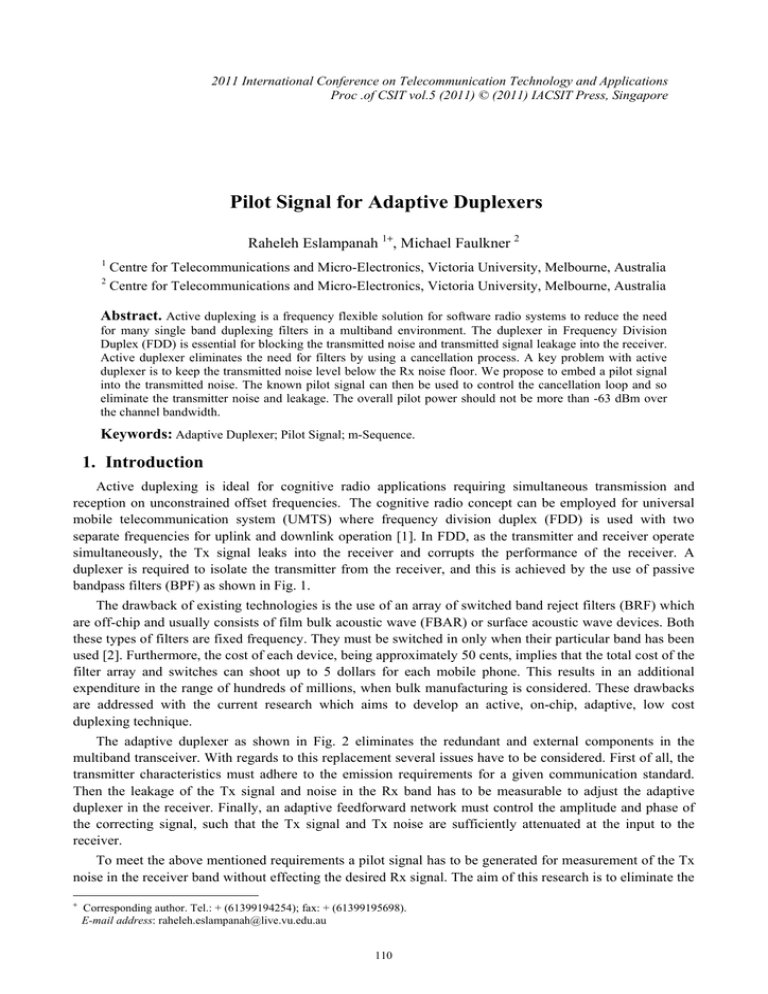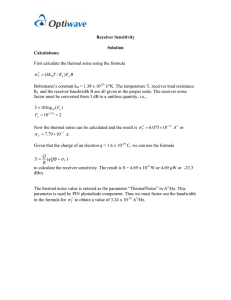Document 13134400
advertisement

2011 International Conference on Telecommunication Technology and Applications Proc .of CSIT vol.5 (2011) © (2011) IACSIT Press, Singapore Pilot Signal for Adaptive Duplexers Raheleh Eslampanah 1+, Michael Faulkner 2 1 2 Centre for Telecommunications and Micro-Electronics, Victoria University, Melbourne, Australia Centre for Telecommunications and Micro-Electronics, Victoria University, Melbourne, Australia Abstract. Active duplexing is a frequency flexible solution for software radio systems to reduce the need for many single band duplexing filters in a multiband environment. The duplexer in Frequency Division Duplex (FDD) is essential for blocking the transmitted noise and transmitted signal leakage into the receiver. Active duplexer eliminates the need for filters by using a cancellation process. A key problem with active duplexer is to keep the transmitted noise level below the Rx noise floor. We propose to embed a pilot signal into the transmitted noise. The known pilot signal can then be used to control the cancellation loop and so eliminate the transmitter noise and leakage. The overall pilot power should not be more than -63 dBm over the channel bandwidth. Keywords: Adaptive Duplexer; Pilot Signal; m-Sequence. 1. Introduction Active duplexing is ideal for cognitive radio applications requiring simultaneous transmission and reception on unconstrained offset frequencies. The cognitive radio concept can be employed for universal mobile telecommunication system (UMTS) where frequency division duplex (FDD) is used with two separate frequencies for uplink and downlink operation [1]. In FDD, as the transmitter and receiver operate simultaneously, the Tx signal leaks into the receiver and corrupts the performance of the receiver. A duplexer is required to isolate the transmitter from the receiver, and this is achieved by the use of passive bandpass filters (BPF) as shown in Fig. 1. The drawback of existing technologies is the use of an array of switched band reject filters (BRF) which are off-chip and usually consists of film bulk acoustic wave (FBAR) or surface acoustic wave devices. Both these types of filters are fixed frequency. They must be switched in only when their particular band has been used [2]. Furthermore, the cost of each device, being approximately 50 cents, implies that the total cost of the filter array and switches can shoot up to 5 dollars for each mobile phone. This results in an additional expenditure in the range of hundreds of millions, when bulk manufacturing is considered. These drawbacks are addressed with the current research which aims to develop an active, on-chip, adaptive, low cost duplexing technique. The adaptive duplexer as shown in Fig. 2 eliminates the redundant and external components in the multiband transceiver. With regards to this replacement several issues have to be considered. First of all, the transmitter characteristics must adhere to the emission requirements for a given communication standard. Then the leakage of the Tx signal and noise in the Rx band has to be measurable to adjust the adaptive duplexer in the receiver. Finally, an adaptive feedforward network must control the amplitude and phase of the correcting signal, such that the Tx signal and Tx noise are sufficiently attenuated at the input to the receiver. To meet the above mentioned requirements a pilot signal has to be generated for measurement of the Tx noise in the receiver band without effecting the desired Rx signal. The aim of this research is to eliminate the + Corresponding author. Tel.: + (61399194254); fax: + (61399195698). E-mail address: raheleh.eslampanah@live.vu.edu.au 110 Tx leakage and Tx noise leakage in the receiver band by using a pilot generation circuit for the adaptive duplexer. In previous work [3], a single in band tone is used as a pilot. This causes interference to the receive signal path. The problem therefore is to remove this pilot tone from the output. To overcome this problem, we propose a spread spectrum pilot signal instead of a pilot tone. This reduces the power spectrum density and so hides the pilot below the noise floor. In this paper, an m-sequence generator using static D flip-flops has been designed and simulated with the use of Peregrine design process based Silicon-on-Sapphire (SOS) technology. This process provides good isolation performance due to the reduction of parasitic coupling into the substrate. Duplexing BPF 1 BPF 2 BPF Duplexer T BPF Tx R (a) Rx Frequency (b) Fig. 1: Conventional duplexer. (a) Hardware structure. (b) Frequency response. 2. Adaptive Duplexer Architecture Without a duplexer, the received signal is difficult to recover due to the transmitted noise. Thus the stopband attenuation of the transmitter has to be high enough such that the Tx noise has to be below the minimum noise floor of the receiver. To remove the switch filters in a traditional duplexer, the proposed adaptive duplexer provides isolation with a two step process. The initial isolation can be achieved by using circulator to get 20 dB isolation. The low isolation device results in a Tx leakage signal that is reduced in the next step. The second step which provides 40 dB isolation is a cancellation unit that can decrease the Tx noise and leakage which can be controlled by adjusting the cancellation loop [2]. In this system, showing Fig. 2, the transmitter sends the transmitted signal, S (t), with transmitted noise, n (t), as they pass through the low isolation device (circulator) via the antenna into the receiver. A sample of the Tx signal and Tx noise leakage are passed through the cancellation loop made up of delays which are τ1 τ 1 = τ b − τ a and τ2 τ 2 = τ c − τ a and gain-phase adjusters h1 and h2. The terms of e1 and e2 which are representative for the measurement of the residual transmit signal and transmit noise leakages respectively. The values of e1 and e2 are passed on to the DSP block. The equations that explain the process of the system block are as follows [4]: ( u( t ) = (s(t ) + n( t ) ) 1 + h1e − jωτ 1 + h2e − jωτ 2 ) (1) ( ) (2) ( ) (3) e1 = s(t ) 1 + h1e − jωTxτ 1 + h2e− jωTxτ 2 e2 = n( t ) 1 + h1e − jωRxτ1 + h2e − jωRxτ 2 The convergence goal is to reduce e1 and e2 to zero, so that the leakage of the transmitted signal and the transmitted noise leakage which drops in the receiver band are measured. To meet this requirement a baseband reference signal is created and cross correlated with the transmitted baseband signal. 111 Antenna Tx signals Tx r(t) s(t)+ n(t) Reference τ1 U(t) Path L Low isolation device TX leakage signals 1 Gain-Phase Adjusters Pilot signal τ2 h1 DSP h2 -1 P x1 x2 e1 Control e2 Rx Fig. 2: Adaptive Duplexer Architecture A direct sequence spread spectrum (DSSS) low level pilot is generated as a reference signal and added to the transmitted noise leakage at the receiver frequency. It is upconverted to the receiver band frequency and added to the transmitter signal (Fig. 3). Most of this signal is transmitted from the antenna but because the circulator is not perfect some of this signal leaks into the receiver circuits. The output of the receiver consists of the wanted Rx signal, the Tx noise (falling in the Rx band), and the pilot signal. Cross correlating the pilot signal with the Rx signal leads to error signal, e2 which measures the amount of pilot in the Rx signal. The purpose is to use the pilot to adjust the feed forward coefficients to cancel the transmitter noise by driving e2 to zero. The error signal e1 represents the amount of Tx leakage signal (in the Tx band) and is detected by a separate receiver. The transmitter output spectrum mask which is plotted in Fig. 3. specifies the level of the emissions in all bands. Therefore the level of the pilot signal cannot be more than -63 dBm measured with a channel bandwidth of 3.84 MHz [4]. Tx signal ideal Pilot signal Fig. 3: The transmitter output spectrum 3. The Proposed PN sequence Generator and D Flip Flop In this application, we use a pseudo noise (PN) signal as the spread spectrum pilot signal. It is generated at a low level such that it is hidden below the transmit noise floor. In this way interference to the incoming received signal (which is on the same channel) is minimised. The pseudo noise signal is produced from an ‘m’-sequence generator based on a polynomial equation [5]. It’s white noise-like spectrum and its good autocorrelation qualities are the most important characteristics for this project. Because of this feature, a sample of white noise model is formed in the receiver [6]. A Linear feedback shift register (LFRS) with specific feedback settings forms an economical, fast, and efficient method for pilot generation. The proposed circuit and simulation results have been illustrated in Fig. 4. and 5. The power consumed by the circuit is 0.85nW which is significantly small for this application. 112 h10 D R SET CLR Q h9 D Q SET CLR Q SET CLR Q Q h6 h7 h8 D Q D SET CLR D Q Q SET CLR h5 D Q Q SET CLR Q Q SET CLR h2 h3 h4 D D Q Q SET CLR Q Q D SET CLR Q Q h1 D SET CLR Q D Q SET CLR Q Q CLK Fig. 4: PN sequence with a maximum length of 2047 Fig. 5: Result for PN sequence (Power consumption: 0.85 nw) A static Master Slave structure has been designed with a transmission gate which is depicted in Fig. 6. The main advantage of this circuit is the reduced number of transistors which leads to a decline of chip density and low power operation and cost [7]. Table 1 shows the sizing of the transistors and simulation result with the use of Peregrine SOS technology. 4. Conclusion An adaptive duplexer using pilot signal has been described. The pilot signal is used to adjust feed forward coefficients to cancel the transmitter noise in an active duplexer structure. This PN pilot is transmitted at low power, so it can be hidden underneath the main transmitter noise floor. The advantages such as the use of an isolated substrate, low component count, low power consumption and minimizes the probability of signal leakage to other parts of the circuit are considered for this system. Q CLKB CLK INV1 INV2 D T1 INV3 QB T2 CLKB CLK MASTER SLAVE Fig. 6: circuit diagram of D flip flop TABLE I. ASPECT RATIO FOR 0.5 µM SOS FC PROCESS Transistor T1,T2 INV1,2 INV3 TG PMOS NMOS PMOS NMOS PMOS NMOS Type RN RP RN RP RN RP RN Size(µm) 8/0.8 8/0.5 4/0.8 2.4/0.5 1.2/0.8 1.2/0.5 1.2/0.8 5. References [1] [2] [3] Y. Li, S. McLaughlin, and D. G. M. Cruickshank, “UMTS FDD Frequency Domain Equalization Based on Self Cyclic Reconstruction”, IEEE International Conference on Communications ICC 2005, pp. 2122 – 2126, vol. 3, 16-20 May 2005. S. Kannangara and M. Faulkner, “Adaptive Duplexer for Multiband Transreceiver”, Proceeding of Radio and Wireless Conference (RAWCON '03), pp. 381 – 384, 10-13 Aug. 2003. M. Williamson, S. Kannangara and M. Faulkner, “Performance Analysis of Adaptive Wideband Duplexer”, Australian Telecommunication Networks and Applications Conference (ATNAC 2003), 2003. 113 [4] [5] [6] [7] M.rdWilliamson and M. Faulkner, “Effect of Spread Spectrum Pilot on an SVD Based Adaptive Duplexer”, IEEE 63 Vehicular Technology Conference (VTC 2006-Spring), Melbourne, Vic., vol. 6, pp. 2762 – 2766, 7-10 May 2006. A. Mitra, “On the Properties of Pseudo Noise Sequences with a Simple Proposal of Randomness Test”, International Journal of Electrical and Computer Engineering, vol. 3, no. 3, pp. 164-169, Spring 2008. N. Yixia, Z. nd Ziqiang, S. Jijiang and L. Yueran, “Pseudo-random Sequence Correlation Simulation Based on MATLAB”, 2 International Conference on Computer Modeling and Simulation (ICCMS’10), vol. 1, pp. 23-25, 22-24 Jan. 2010. M. Sharma, A. Noor, S. C. Tiwari and K. Singh, “An Area and Power Efficient design of Single Edge Triggered DFlip Flop”, International Conference on Advances in Recent Technologies in Communication and Computing, pp. 478-481, 27-28 Oct. 2009. 114






